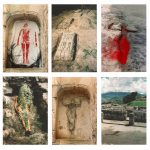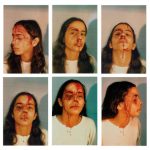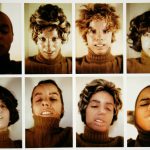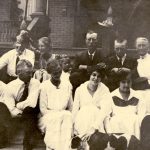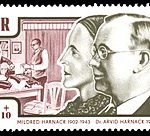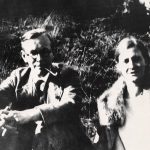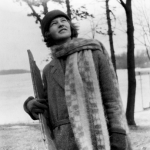Name: Ana Mendieta
Birth: November 18, 1948 Death: September 8, 1985
- Credit The Estate of Ana Mendieta Collection, LLC, via Galerie Lelong & Co.
- Ana Mendieta, Silueta Works in Mexico, 1973–77/1991. Courtesy the Galerie Lelong. © The Estate of Ana Mendieta Collection, LLC.
- Untitled (Self-Portrait with Blood) 1973
- Untitled (Facial Cosmetic Variations), 1972
What she did: Cuban American performance artist, sculptor, painter and video artist who is best known for her “earth-body” artwork.
- Ana Maria Mendieta was born into a middle-class family in Havana on Nov. 18, 1948.
- Her father, Ignacio, was a prominent political figure who ran afoul of Fidel Castro’s government; her mother, Raquel, was a chemistry teacher.
- At age 12, Ana and her 14-year-old sister Raquelin were sent to the United States by their parents to live in Dubuque, Iowa through Operation Peter Pan, a collaborative program run by the US government and the Catholic Charities.
- Ana and her sister were among 14,000 children who immigrated to America on their own in 1961.
- Ana’s first two years in the United States consisted of constantly moving from place to place. The sisters were able to stay together during this time due to a power of attorney signed by their parents mandating that they not be separated.
- When she and her sister were sent to Iowa, they were enrolled in a reform school because the court wanted to avoid sending them to a state institution.
- When Ana studied English in school, her vocabulary was very limited. In junior high school, she discovered a love for art.
- In 1966, Ana was reunited with her mother and younger brother; her father joined them in 1979, having spent 18 years in a political prison in Cuba for his involvement in the Bay of Pigs invasion.
- Ana was first a French major and art minor, but when she transferred to the University of Iowa, she was inspired by the avant-garde community and the hills of Iowa’s landscape.
- She earned a BA and MA in painting and an MFA in Intermedia under the instruction of acclaimed artist Hans Breder.
- In college, Mendieta’s work focused on blood and violence toward women. Her interest in spiritual and religious things and primitive rituals developed during this time.
- She has said that she faced a great deal of discrimination in art school. After graduate school, Ana moved to New York.
Work
- Through the course of her career, Ana created work in Cuba, Mexico, Italy, and the United States.
- Her work was somewhat autobiographical, drawing from her history of being displaced from her natal Cuba, and focused on themes including feminism, violence, life, death, identity, place and belonging.
- Her works are generally associated with the four basic elements of nature. Ana often focused on a spiritual and physical connection with the Earth. Ana felt that by uniting her body with the earth she could became whole again: “Through my earth/body sculptures, I become one with the earth … I become an extension of nature and nature becomes an extension of my body. This obsessive act of reasserting my ties with the earth is really the reactivation of primeval beliefs … [in] an omnipresent female force, the after image of being encompassing within the womb, is a manifestation of my thirst for being.”
- During her lifetime, Mendieta produced over 200 works of art using earth as a sculptural medium.
- Ana Mendieta’s art was sometimes violent, often unapologetically feminist and usually raw.
- She incorporated unusual natural materials like blood, dirt, water and fire, and displayed her work through photography, film and live performances.
- “Nothing that she did ever surprised me,” Mendieta’s sister, Raquelín, told The New York Times in 2016. “She was always very dramatic, even as a child — and liked to push the envelope, to give people a start, to shock them a little bit. It was who she was, and she enjoyed it very much. And she laughed about it sometimes when people got freaked out.”
- As an immigrant, Mendieta felt a disconnect in the United States. The trauma of being uprooted from her Cuban homeland as a girl would leave her with questions about her identity and make her more conscious of being a woman of color.
- These questions would echo in her work, which explored themes that pushed ethnic, sexual, moral, religious and political boundaries. She urged viewers to disregard their gender, race or other defining societal factors and instead connect with the humanity they share with others.
- In 1978, Ana joined the Artists In Residence Inc (A.I.R. Gallery) in New York, which was the first gallery for women to be established in the United States.
- During that time, Ana was also actively involved in the administration and maintenance of the A.I.R. In an unpublished statement, Ana noted that “It is crucial for me to be a part of all my art works. As a result of my participation, my vision becomes a reality and part of my experiences.”
- At the same time, after two years of her involvement at A.I.R. she concluded that “American Feminism as it stands is basically a white middle class movement,” and sought to challenge the limits of this perspective through her art. She met her future husband Carl Andre at the gallery when he served on a panel titled, “How has women’s art practices affected male artist social attitudes?”
- Her resignation in 1982 is attributed, in part, to a dispute instigated by Andre over a collaborative art piece the couple had submitted. In a 2001 journal article, Kat Griefen, director of A.I.R from 2006–2011,[14] wrote, The letter of resignation did not site any reasons for her departure, but a number of fellow A.I.R. artists remember the related events. For a recent benefit Ana and Carl Andre had donated a collaborative piece. As was the policy, all works needed to be delivered by the artist. Edelson recalls that Andre took offense, instigating a disagreement, which, in part, led to Mendieta’s resignation. Even without this incident, according to another member, Pat Lasch, Ana’s association with the now legendary Andre surely played some role in her decision.
- In 1983, Mendieta was awarded the Rome Prize from the American Academy in Rome. While in residence in Rome, Mendieta began creating art “objects,” including drawings and sculptures. She continued to use natural elements in her work.
- Silueta Series (1973–1980)
- The Silueta Series (1973–1980) involved Ana creating female silhouettes in nature—in mud, sand, and grass—with natural materials ranging from leaves and twigs to blood, and making body prints or painting her outline or silhouette onto a wall.
- When she began her Silueta Series in the 1970s, Ana was one of many artists experimenting with the emerging genres of land art, body art, and performance art. The films and photographs of Siluetas are in connection with the figures surrounding her body.
- Ana was possibly the first to combine these genres in what she called “earth-body” sculptures. She often used her naked body to explore and connect with the Earth.
- Ana’s first use of blood to make art dates from 1972, when she performed Untitled (Death of a Chicken), for which she stood naked in front of a white wall holding a freshly decapitated chicken by its feet as its blood spattered her naked body.
- In a slide series, People Looking at Blood Moffitt (1973), she pours blood and rags on a sidewalk and photographs a seemingly endless stream of people walking by without stopping, until the man next door comes out to clean it up.
- Mendieta also created the female silhouette using nature as both her canvas and her medium. She used her body to create silhouettes in the grass; she created silhouettes in sand and dirt; she created silhouettes of fire and filmed them burning. Untitled (Ochún) (1981), named for the Santería goddess of waters, once pointed southward from the shore at Key Biscayne, Florida. Ñañigo Burial (1976), with a title taken from the popular name for an Afro-Cuban religious brotherhood, is a floor installation of black candles dripping wax in the outline of the artist’s body.
- Through these works, which cross the boundaries of performance, film, and photography, Mendieta explored her relationship with a place as well as a larger relationship with mother Earth or the “Great Goddess” figure.
- Many have interpreted Mendieta’s recurring use of this mother figure, and her own female silhouette, as feminist art. However, because Mendieta’s work explores many ideas including life, death, identity, and place all at once, it cannot be categorized as part of one idea or movement.
- Claire Raymond argues that the Silueta Series, as a photographic archive, should be read for its photographicity rather than merely as documentation of earthworks.
- Photo etchings of the Rupestrian Sculptures (1981)
- As documented in the book Ana Mendieta: A Book of Works, edited by Bonnie Clearwater, before her death, Mendieta was working on a series of photo-etchings of cave sculptures she had created at Escaleras de Jaruco, Jaruco State Park in Havana, Cuba.
- Her sculptures were entitled Rupestrian Sculptures (1981)—the title refers to living among rocks—and the book of photographic etchings that Ana was created to preserve these sculptures is a testament to the intertextuality of Ana’s work.
- Clearwater explains how the photographs of Ana’s sculptures were often as important as the piece they were documenting because the nature of Ana’s work was so impermanent. Ana spent as much time and thought on the creation of the photographs as she did on the sculptures themselves.
- Ana returned to Havana, the place of her birth, for this project, but she was still exploring her sense of displacement and loss, according to Clearwater.
- The Rupestrian Sculptures that Ana created were also influenced by the Taíno people, “native inhabitants of the pre-Hispanic Antilles,” which Mendieta became fascinated by and studied.
- Ana had completed five photo-etchings of the Rupestrian Sculptures before she died in 1985. The book Ana Mendieta: A Book of Works, published in 1993, contains both photographs of the sculptures as well as Mendieta’s notes on the project.
- Body Tracks (1982)
- Body Tracks (Rastros Corporales) are long, blurry marks that Mendieta’s hands and forearms made as they slid down a large piece of white paper during a performance heightened with pulsing Cuban music.
- In 1979 Ana presented a solo exhibition of her photographs at A.I.R. Gallery in New York.She also curated and wrote the introductory catalog essay for an exhibition at A.I.R. in 1981 entitled Dialectics of Isolation: An Exhibition of Third World Women Artists of the United States, which featured the work of artists such as Judy Baca, Senga Nengudi, Howardena Pindell, and Zarina.
- Ana Mendieta died on September 8, 1985, in New York after falling from her 34th-floor apartment in Greenwich Village’s 300 Mercer Street, where she lived with her husband of eight months, minimalist sculptor Carl Andre, who may have pushed her out the window.
- She fell 33 stories onto the roof of a deli.
- Just prior to her death, neighbors heard the couple arguing violently. There were no eyewitnesses to the events that led up to Ana’s death.
- A recording of Andre’s 911 call showed him saying: “My wife is an artist, and I’m an artist, and we had a quarrel about the fact that I was more, eh, exposed to the public than she was. And she went to the bedroom, and I went after her, and she went out the window.”
- In 1988, Andre was tried and acquitted of her murder. During three years of legal proceedings,Andre’s lawyer described Ana’s death as a possible accident or suicide.
- The judge found Andre not guilty on grounds of reasonable doubt.
- The acquittal caused an uproar among feminists in the art world, and continues to remain controversial to this day.
- In 2010, a symposium called Where Is Ana Mendieta was held at New York University to commemorate the 25th anniversary of her death.
- In May 2014, the feminist protest group No Wave Performance Task Force staged a protest in front of the Dia Art Foundation’s retrospective on Carl Andre. The group deposited piles of animal blood and guts in front of the establishment, with protesters donning transparent tracksuits with “I Wish Ana Mendieta Was Still Alive” written on them.
- In March 2015, the No Wave Performance Task Force and a group of feminist poets from New York City traveled to Beacon, New York to protest the Andre retrospective at Dia: Beacon, where they cried loudly in the main gallery, made “siluetas” in the snow on museum grounds, and stained the snow with paprika, sprinkles, and fake blood.
- In April 2017, protesters at an Andre retrospective handed out cards at the Geffen Contemporary with the statement Carl Andre is at MOCA Geffen. ¿Dónde está Ana Mendieta?” (Where is Ana Mendieta?). This was followed by an open letter to MOCA Director Philippe Vergne protesting the exhibit from the group the Association of Hysteric Curators.
Legacy
- In 2009, Ana was awarded a Lifetime Achievement Award by the Cintas Foundation.
- Ana Mendieta’s estate is currently managed by the Galerie Lelong in New York City. The estate is also represented by Alison Jacques Gallery, London.
- In 2018, The New York Times published a belated obituary for her.
- The New Museum of Contemporary Art in New York hosted Ana’s first survey exhibition in 1987.
- Since her death, Ana has been recognized with international solo museum retrospectives such as “Ana Mendieta”, Art Institute of Chicago (2011); and “Ana Mendieta in Context: Public and Private Work”, De La Cruz Collection, Miami (2012).[42]In 2004 the Hirshhorn Museum and Sculpture Garden in Washington, D.C., organized “Earth Body, Sculpture and Performance”, a major retrospective that travelled to the Whitney Museum of American Art, New York, Des Moines Art Center, Iowa, and Miami Art Museum, Florida (2004).
- Ana’s work features in many major public collections, including the Solomon R. Guggenheim Museum, Metropolitan Museum of Art, Whitney Museum of American Art, and Museum of Modern Art in New York; the Art Institute of Chicago; Centre Pompidou, Paris; Musée d’Art Moderne et Contemporain, Geneva; and Tate Collection, London.

Name: Mildred Fish Harnack
Birth: September 16, 1902 Death: February 16, 1943)
- Mildred (top row, second from the left) acting silly with family and friends (1917) – Courtesy of the UW Digital Collections Center.
- Commemorative stamp for Mildred Harnack and her husband Arvid issued by Deutsche Post of the GDR
- Mildred and Arvid moved from the US to Germany (1930). – Courtesy of the UW Digital Collections Center.
- Mildred studied literature at UW-Madison (1923). – Courtesy of the UW Digital Collections Center.
What she did: Nazi Resistance Fighter
- Mildred Harnack was born on September 16 th , 1902 in good old Milwaukee, WI as one of four children to German-American parents. She grew up in a large population of German immigrants and grew up learning how to read, write, and speak in both German and English.
- In 1919 her family briefly moved to Washington, DC but Mildred returned to Wisconsin in 1921 to attend university. She studied English literature and was a skilled writer. Her stories and poems were published in the Wisconsin Literary Magazine and she eventually became an assistant editor for the magazine.
- In 1925, Mildred earned her Bachelor of Arts in English and then her Masters in English in 1926. While working and studying at the university as a lecturer on German literature, she met German jurist Arvid Harnack and the two were wed.
- Mildred eventually left her job at the Wisconsin Literary Magazine before moving to Baltimore, Maryland where she taught English at Goucher College.
- In 1929, Mildred and Arvid moved to Germany where Mildred worked on earning her doctorate at the University of Giessen.
- Then, in 1930, she moved to Berlin and studied at the University of Berlin where she also worked as a lecturer in English and American literature and as a translator. She also worked with the American Student Association, served as president of the American Women’s club, and was secretary of the Berlin chapter of the Daughters of the American Revolution.
- In 1932, Mildred was fired from her teaching position for being a foreigner and a woman. I’m assuming this was under the same act that removed Jews from government service.
- Without a job, she and Arvid joined other academics on a tour of the United States and Soviet Union. Mildred had become interested in Communism and its potential as a solution to poverty.
- Mildred and Arvid had a lot of connections in Germany and in 1937 they began inviting friends over to chat politics. While most people today can’t get through a single meal without bringing up politics, at the time this was incredibly dangerous as saying anything negative about the government could get you arrested.
- Then, Germany and the Soviet Union officially went to war. Mildred and Arvid would not stand by.
- That group of friends coming over for political discussions became the Red Orchestra, a Nazi resistance group helping the Soviet Union. They came up with the name because they named their secret radio transmitters after musical instruments.
- From 1940 through 1941, the Red Orchestra supported the Soviets by transmitting messages to Soviet fighters that revealed information about the Nazi air force, planned attacks, the number of planes, how much fuel they had, and even where they were storing chemical weapons.
- Mildred helped send information to the Soviets regarding Operation Barbossa which was the planned Nazi invasion of Russia so the Nazis could repopulate Russia with Germans and use the Russians as slaves. Mildred also worked to recruit others for the resistance, working as a contact between her husband, other members of the Red Orchestra, and Soviet agents.
- In the midst of all of this, Mildred also managed to earn her doctorate!
- Unfortunately, because Nazis ruin everything, they discovered who was behind the Red Orchestra. I read in one account that they captured a Soviet spy who revealed their identities and in another the Nazis decoded a message from them.
- However it happened, Mildred, Arvid, and 116 other members of the Red Orchestra were arrested.
- In December of 1942, after a four day trial, Mildred and Arvid were found guilty of espionage. Arvid was sentenced to death and hanged on Christmas Eve of the same year.
- Initially, Mildred was sentenced to 4 or 6 (history) years in a prison camp. However, this was not good enough for Hitler, who refused to endorse her sentence. On his orders, she was retried and sentenced to death.
- Mildred spend her last month in prison reading, and translating works of poetry.
- On February 16 th , 1943, at 42 years old, Mildred was beheaded. Her last words were “I have loved Germany so much.”
- This made Mildred the only American woman executed on Hitler’s orders.
- After Mildred was executed, her body was turned over to Hermann Stieve, an anatomy professor at Humboldt University who then dissected her to study the effects of stress on the menstrual cycle.
- This next part I’m quoting straight from Wikipedia because it’s so creepy:
“After he was through, he gave WHAT WAS LEFT to a friend of hers.” - Mildred was buried in Berlin’s Zehlendorf Cemetery, making her the only member of the Red Orchestra whose burial site is known. However, the headstone in Zehlendorf Cemetery bears both her name and Arvid’s.
LEGACY
- Mildred is celebrated in Wisconsin on her birthday, September 16th.
- Though she’s not very well known, Mildred is remembered as a hero.
- There is a book available on Amazon called Resisting Hitler: Mildred Harnack and the Red Orchestra which looks pretty fucking amazing.

